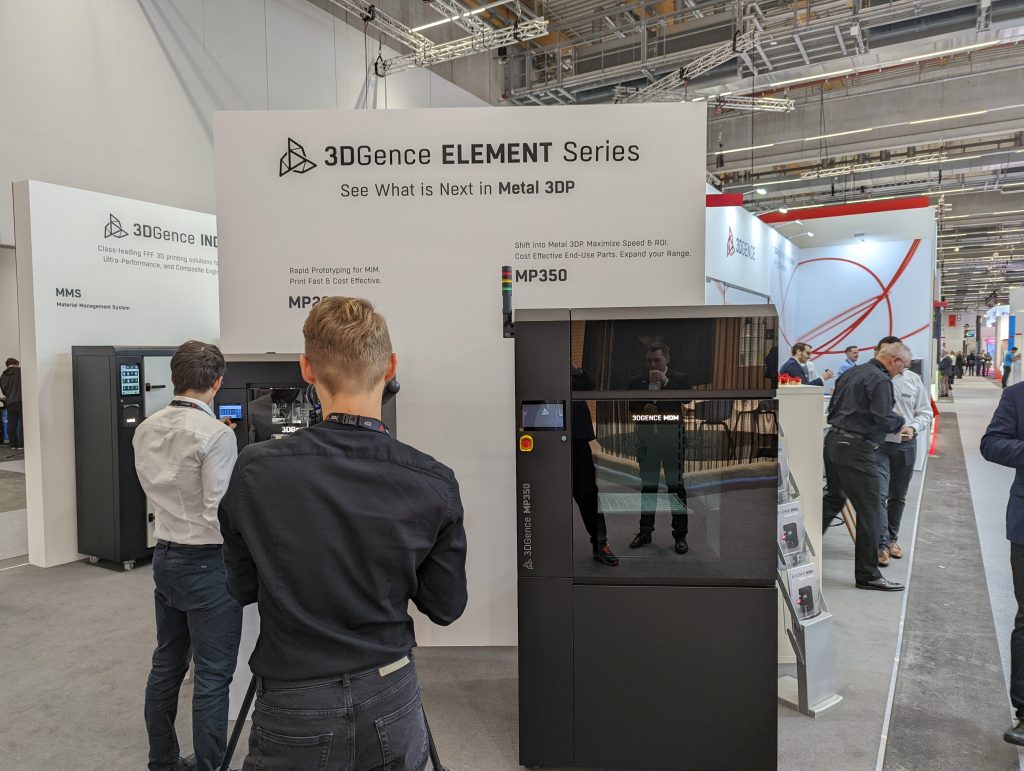The 3D printing industry is back together in Frankfurt for a highly anticipated Formnext. Spread across halls eleven and twelve, the largest 3D printing event of the year is now open. The 3D Printing Industry team is in Frankfurt for the week, and I took a first look at some of the new 3D printers, trends, and new materials at this week’s show.
Heike Pfab, Deputy Vice President of Formnext, in between a series of phone calls as she helps organize the final stages of the event Pfab tells me, “People are very excited and happy to meet again”. This almost goes without saying, and the atmosphere on the pre-show floor is tangible – the additive manufacturing community thrives in person. Very quickly I am getting reacquainted with familiar faces and sparking up conversations as I move through the three event halls and surrounding area.
Waiting in line to register for my vaccination identification, the event runs under the 2G rule requiring strict Covid protocol to be followed, I meet a masked Cody Burke, COO & Co-founder, at PrintParts. PrintParts recently won the Formnext Start-up Challenge. “Winning has made us level up”, he tells me. PrintParts join fellow winners Azul3D, Fited, ATLANT 3D Nanosystems, and Nobula glass 3D printing in Hall 12’s start-up zone. This afternoon, the winners and other promising start-ups will take part in the pitch next event where visitors can learn more about these promising companies.
Formnext 2021 is big, trends in AM
It is hard to ignore one of the major 3D printing trends coming to the surface at Formnext 2021. Across the trade show floor, huge 3D printers are dotted throughout the building. In Hall 12 at booth C101, Roboze will be difficult to miss. The Roboze Argo 1000 has a build volume of 1x1x1 meters and can use the most challenging of high-performance materials such as the coveted PEEK. The stylish looking system is complemented by the smaller Argo 500.

Also hard to miss, is Massivit3D. A full-size sports car in a nifty turquoise and white color scheme illustrates the possibilities of functional prototypes on their systems. The Massivit 5000 is another enormous 3D printer that dominates the booth.

If speed is more your cup of tea then don’t miss a company that might be a newcomer to the show, but is led by an experienced executive team. AXTRA3D’s founder, CEO & CTO is Gianni Zitelli who previously developed the technology used by Nexa3D, more about Nexa3D later. Together with Praveen Tummula, Chief Operations, and Business Officer and co-founder, Zitelli talked me through how AXTRA3D is commercializing three of the six patents the company has filed.
AXTRA3D’s first 3D printer uses a combination of SLA and DLP resin 3D printing. They call this platform Hybrid Photosynthesis (HPS). Taking the benefits of SLA, excellent surface quality and scalability, and mixing in the speed of an LCD system. Where LCD can print full layers, scaling loses resolutions and suffers the aliasing effect. “Developers tried for a long time to combine both processes,” Zitelli tells me. However, there were issues with full polymerization of the resin due to the processes taking place separately. AXTRA3D’s “secret” is concurrent operation with DLP and SLA working at the same time, on the same wavelength with the same energy.
The speed is 18cm per hour on the Z-axis, producing isotropic parts. We will be taking a closer look at this company during the week, if you can’t wait then don’t miss AXTRA3D at booth C41 in Hall 12.


So what about Nexa3D, the start-up that Avi Reichental is now at the helm of. Nexa3D has transformed from a start-up presence at Formnext to having a vast booth showcasing its resin systems and material portfolio. However, what is noteworthy here is something that seemingly goes not only against the trend at Formnext to “go-large” but also a wider trend in the 3D printing industry. Nexa3D, in case the presence of YouTuber Joel Telling, aka the 3D Printing Nerd, did not already make apparent, is targeting the hobbyist/desktop market.
Nexa3D has launched the XIP (pronounced zip). While the team remained tight-lipped about the XiP desktop resin 3D printer, I was able to ascertain the price point will be similar to a Formlabs system. This is notable as with the increasing availability of resin 3D printers at very low prices, the move seems unusual. The XiP has a build volume of 190 x 120 x 170 mm and runs a monochrome 9.3” LCD screen at 4K STD resolution. To manage this new business segment Michael Currie, an exec with experience at Oracle, HubSpot, Formlabs, and most recently Gecko Robotics, has been hired. Those in the 3D printing industry with longer memories may be reminded of Reichental’s earlier foray into the desktop market while CEO at 3D Systems.

Back on the industrial track 3DGence at booth B119 in Hall 12.1. The company has two eye-catching new 3D printers – both available in any color, so long as it’s black. The MP260 is now commercially available while the MP350 will be available in Q2 of next year. Both systems are FFF-based and join the trend towards running metal materials via a MIM-based process. Unlike many companies in the industry who have adopted BASF’s Ultrafuse, 3DGence has its own “secret recipe” that the company tells me removes certain restrictions of the BASF material.

For now, that’s the first glimpse at formnext. The 3D Printing Industry team will be in Frankfurt all week, so make sure you say hello if you see us.
Subscribe to the 3D Printing Industry newsletter for the latest news in additive manufacturing. You can also stay connected by following us on Twitter, liking us on Facebook, and tuning into the 3D Printing Industry YouTube Channel.
Looking for a career in additive manufacturing? Visit 3D Printing Jobs for a selection of roles in the industry.


